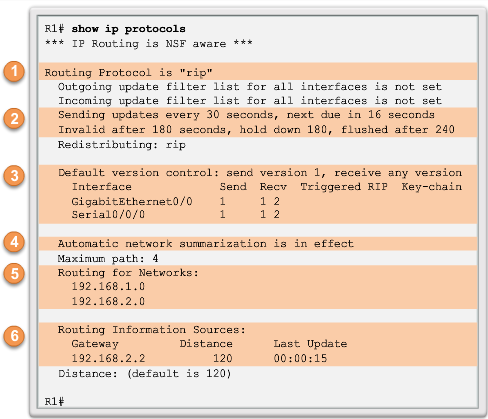Configuration:
To enable RIP routing for a network, use the network network-address router configuration mode command. Enter the classful network address for each directly connected network. This command:
- Enables RIP on all interfaces that belong to a specific network. Associated interfaces now both send and receive RIP updates.
- Advertises the specified network in RIP routing updates sent to other routers every 30 seconds.
Note: If a subnet address is entered, the IOS automatically converts it to the classful network address. Remember RIPv1 is a classful routing protocol for IPv4. For example, entering the network 192.168.1.32 command would automatically be converted to network 192.168.1.0 in the running configuration file. The IOS does not give an error message, but instead corrects the input and enters the classful network address.
RIP Routing: Mandatory Commands
Router(config)#router rip //Enables RIP as a routing protocol Router(config-router)#network w.x.y.z //w.x.y.z is the network number of the directly connected network you want to advertise
RIP optional commands
| Router(config)#no router rip | Turn off the RIP routing process |
| router(config-router)#no network w.x.y.z | remove network w.x.y.z from the routing process |
| router(config-router)#passive-interface s0/0 | RIP updates will not be sent out from s0/0 |
| router(config-router)#neighbor a.b.c.d | defines a specific neighbor with which to exchange information |
| router(config-router)#no ip split-horizon | turn off split horizon |
| router(config-router)#ip split-horizon | enable split horizon |
| router(config-router)#timers basic 30 90 180 270 360 | 30=update timer (in seconds)
90=invalid timer(in seconds) 180=hold-down timer(in seconds) 270=flush timer(in seconds) 360=sleep time(in milliseconds) |
| router(config-router)#maximum-paths x | limits the number of paths for loading balancing to x.
(default is 4, max is 6) |
| router(config-router)#default-information originate | genereates a default route into RIP. |
Examing RIP version 1:
The show ip protocols command displays the IPv4 routing protocol settings currently configured on the router. This output displayed in Figure confirms most RIP parameters including:
1. RIP routing is configured and running on router R1.
2. The values of various timers; for example, the next routing update, is sent by R1 in 16 seconds.
3. The version of RIP configured is currently RIPv1.
4. R1 is currently summarizing at the classful network boundary.
5. The classful networks are advertised by R1. These are the networks that R1 include in its RIP updates.
6. The RIP neighbors are listed including their next-hop IP address, the associated AD that R2 uses for updates sent by this neighbor and when the last update was received from this neighbor.
Note: This command is also very useful when verifying the operations of other routing protocols (i.e., EIGRP and OSPF).
Rip Version 2
Differences between version 1
- RIPv1 is a classful routing protocol, RIPv2 is classless protocol.
- RIPv1 use broadcast to update the routing table, RIPv2 uses multicasts (224.0.0.9) rather than broadcasts to 255.255.255.255.
- RIPv1 don’t support VLSM, RIPv2 supports VLSM
- RIPv1 don’t support manual route summarization, RIPv2 support manual route summarization.
- RIPv2 supports MD5 authentication for routing updates
| router(config-router)#version 2 | Rip will send and receive RIP-2 packets |
| router(config-if)#ip rip send version 1 | Interface will send only RIP-1 packets |
| router(config-if)#ip rip send version 2 | interface will send only RIP-2 packets |
| router(config-if)#ip rip send version 1 2 | interface will send both Rip-1 and Rip-2 packets |
| router(config-if)#ip rip receive version 1 | interface will receive only Rip-1 packets |
| router(config-if)#ip rip receive version 2 | interface will receive only rip-2 packets |
| router(config-if)#ip rip receive version 1 2 | interface will receive both rip-1 and rip-2 packets |
| Router(config-router)#no auto-summary | Turns autosummarization off for RIP-2 |
| Router(config-router)#auto-summary | turn auto summarization on |
| Router(config-router)#no version 2 | changes back to rip-1 |
| Router(config-router)#version 1 | changes RIP routing to rip-1 |
| Router#clear ip route * | Force routing table to update immediatly |
Propagating a default route
It is more scalable to enter the default route once on the edge router R1 and then have R1 propagate it to all other routers using RIP. To provide Internet connectivity to all other networks in the RIP routing domain, the default static route needs to be advertised to all other routers that use the dynamic routing protocol.
To propagate a default route, the edge router must be configured with:
- A default static route using the ip route 0.0.0.0 0.0.0.0 exit-intf next-hop-ip command.
- The default-information originate router configuration command. This instructs R1 router to originate default information, by propagating the static default route in RIP updates.
Reference: cisco website.